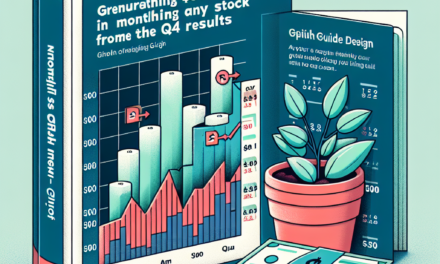“Market Momentum: Riding the Wave of Trump’s Triumph”
Introduction
Following the unexpected victory of Donald Trump in the U.S. presidential election, the stock market is poised for a significant surge. Investors and analysts are closely monitoring the potential economic policies that the Trump administration may implement, which are anticipated to include tax cuts, deregulation, and increased infrastructure spending. These measures are expected to stimulate economic growth, boost corporate profits, and enhance investor confidence. As a result, market participants are preparing for a bullish trend, with sectors such as finance, construction, and energy likely to benefit the most. The anticipation of these policy changes is driving optimism in the financial markets, setting the stage for a potential rally in stock prices.
Impact Of Political Changes On Stock Market Trends
The stock market often serves as a barometer for investor sentiment, reflecting the collective expectations of future economic conditions. Following the recent electoral victory of Donald Trump, market analysts and investors are keenly observing potential shifts in stock market trends. Historically, political changes have had a profound impact on market dynamics, and Trump’s win is no exception. The anticipation of policy shifts under his administration has already begun to influence market behavior, with many expecting a surge in stock prices.
One of the primary reasons for this anticipated surge is the market’s expectation of pro-business policies. Trump’s campaign promises included significant tax cuts for corporations and individuals, deregulation across various industries, and increased infrastructure spending. These proposals are generally perceived as favorable for economic growth, potentially boosting corporate profits and, consequently, stock prices. Investors are particularly optimistic about sectors such as finance, energy, and construction, which stand to benefit directly from deregulation and increased government spending.
Moreover, the promise of tax reform is likely to have a substantial impact on corporate earnings. Lower corporate tax rates would increase after-tax profits, making stocks more attractive to investors. This expectation has already led to a rally in certain sectors, as investors position themselves to capitalize on potential gains. Additionally, the repatriation of overseas profits, another aspect of Trump’s tax plan, could lead to increased dividends and share buybacks, further driving up stock prices.
However, it is essential to consider the potential risks and uncertainties that accompany these anticipated changes. While the prospect of deregulation and tax cuts is appealing to investors, the implementation of such policies is subject to political negotiation and legislative approval. Any delays or deviations from the proposed plans could lead to market volatility. Furthermore, Trump’s stance on trade, characterized by protectionist rhetoric, poses a risk to global economic stability. Tariffs and trade barriers could disrupt international supply chains, affecting multinational corporations and potentially leading to retaliatory measures from trading partners.
In addition to domestic policy changes, geopolitical factors also play a crucial role in shaping market trends. Trump’s foreign policy approach, which emphasizes a strong national defense and a reevaluation of international alliances, could lead to shifts in global economic relations. Investors must remain vigilant, as any escalation in geopolitical tensions could impact market stability and investor confidence.
Despite these uncertainties, the initial market reaction to Trump’s victory has been largely positive. The Dow Jones Industrial Average and other major indices experienced significant gains in the days following the election, reflecting investor optimism. This rally suggests that, at least in the short term, the market is betting on the potential benefits of a Trump presidency.
In conclusion, the stock market’s anticipation of a surge following Trump’s victory underscores the complex interplay between political changes and market trends. While the promise of pro-business policies fuels investor optimism, the potential risks associated with policy implementation and geopolitical factors cannot be overlooked. As the new administration takes shape, investors will continue to closely monitor developments, adjusting their strategies to navigate the evolving economic landscape. Ultimately, the impact of political changes on stock market trends will depend on the balance between realized policy benefits and the management of associated risks.
Historical Analysis Of Market Reactions To Presidential Elections
The stock market’s reaction to presidential elections has long been a subject of intense scrutiny and analysis, as investors seek to understand how political shifts might influence economic landscapes. Historically, the market’s response to election outcomes can vary significantly, often reflecting the prevailing economic conditions, investor sentiment, and the anticipated policies of the incoming administration. In the wake of Donald Trump’s victory, the stock market is poised for a potential surge, a phenomenon that can be better understood by examining past market behaviors in response to presidential elections.
To begin with, it is essential to recognize that the stock market is inherently forward-looking, with investors making decisions based on their expectations of future economic conditions. Consequently, the market’s reaction to a presidential election is not merely a reflection of the immediate political change but also an anticipation of the policies and economic strategies that the new administration is likely to implement. Historically, markets have shown a tendency to rally following the election of a pro-business candidate, as investors anticipate policies that may stimulate economic growth, reduce regulatory burdens, and foster a favorable business environment.
For instance, the election of Ronald Reagan in 1980 marked a significant turning point for the stock market. Reagan’s pro-business stance and commitment to reducing taxes and government intervention were met with enthusiasm by investors, leading to a sustained bull market throughout much of the 1980s. Similarly, the election of George W. Bush in 2000, despite the contentious nature of the election itself, eventually led to a market rally as investors anticipated tax cuts and deregulation.
In the case of Donald Trump’s victory, the market’s anticipation of a surge can be attributed to several factors. Trump’s campaign promises included significant tax reforms, deregulation, and infrastructure spending, all of which are perceived as catalysts for economic growth. Moreover, his focus on reducing corporate taxes and repatriating overseas profits was expected to boost corporate earnings and, by extension, stock prices. As a result, investors were optimistic about the potential for a more business-friendly environment under Trump’s leadership.
However, it is important to note that while the market may initially react positively to the election of a pro-business candidate, the long-term impact of their policies can be more complex. For example, while tax cuts and deregulation may stimulate short-term economic growth, they can also lead to increased deficits and potential inflationary pressures. Additionally, geopolitical uncertainties and trade policies can introduce volatility and unpredictability into the market.
In conclusion, the stock market’s anticipation of a surge following Donald Trump’s victory is consistent with historical patterns observed in previous elections. Investors’ optimism is largely driven by the expectation of pro-business policies that could stimulate economic growth and enhance corporate profitability. Nevertheless, it is crucial for investors to remain vigilant and consider the broader economic implications of such policies, as well as the potential risks and uncertainties that may arise. By understanding the historical context of market reactions to presidential elections, investors can better navigate the complexities of the financial landscape and make informed decisions in the face of political change.
Investor Sentiment And Market Volatility Post-Election
In the wake of Donald Trump’s unexpected victory in the presidential election, investor sentiment has been marked by a complex mix of optimism and caution, as market participants anticipate a potential surge in the stock market. Historically, elections have been pivotal events that can significantly influence market dynamics, and this election is no exception. The initial reaction to Trump’s win was characterized by volatility, with futures markets experiencing sharp declines overnight. However, as the dust settled, a more optimistic outlook began to take shape, driven by expectations of pro-business policies and regulatory reforms promised by the Trump administration.
Investors are particularly focused on Trump’s proposed tax cuts and infrastructure spending, which are anticipated to stimulate economic growth. These policy initiatives are expected to boost corporate earnings, thereby enhancing stock valuations. Moreover, the promise of deregulation, especially in sectors such as finance and energy, has further fueled positive sentiment among investors. The financial sector, in particular, stands to benefit from a rollback of stringent regulations, potentially leading to increased profitability for banks and financial institutions.
Despite the initial optimism, it is important to acknowledge the underlying uncertainties that accompany any major political transition. While the prospect of fiscal stimulus is appealing, concerns about potential trade protectionism and geopolitical tensions could temper market enthusiasm. Investors are keenly aware that the implementation of Trump’s policies will require negotiation and compromise, which may lead to delays or modifications that could impact market expectations.
Furthermore, the Federal Reserve’s monetary policy remains a critical factor in shaping market sentiment. With the possibility of interest rate hikes on the horizon, investors are closely monitoring the Fed’s actions and statements. Higher interest rates could lead to increased borrowing costs, which might offset some of the anticipated benefits of fiscal stimulus. Consequently, the interplay between fiscal and monetary policy will be a key determinant of market performance in the coming months.
In addition to domestic factors, global economic conditions continue to play a significant role in influencing investor sentiment. The interconnectedness of global markets means that developments in other major economies, such as China and the European Union, can have ripple effects on the U.S. stock market. As such, investors are keeping a watchful eye on international trade relations and economic indicators from around the world.
In conclusion, while the stock market is poised for a potential surge following Trump’s victory, it is essential for investors to remain vigilant and consider the broader economic and political landscape. The initial optimism is tempered by a recognition of the complexities involved in policy implementation and the potential for unforeseen challenges. As the new administration takes shape, market participants will continue to assess the evolving situation, balancing the promise of economic growth with the realities of political and economic uncertainties. By staying informed and adaptable, investors can navigate the post-election landscape with a strategic approach, positioning themselves to capitalize on opportunities while mitigating risks.
Sector-Specific Gains And Losses After Trump’s Win
Following Donald Trump’s victory in the presidential election, the stock market is poised for a significant surge, with sector-specific gains and losses becoming a focal point for investors. As the market digests the implications of Trump’s policies, various sectors are expected to experience differing impacts, reflecting the diverse nature of his proposed economic agenda. This divergence in sector performance underscores the complexity of the market’s response to political changes and highlights the importance of strategic investment decisions.
To begin with, the financial sector is anticipated to benefit considerably from Trump’s presidency. His administration’s commitment to deregulation, particularly the potential rollback of the Dodd-Frank Act, is likely to create a more favorable environment for banks and financial institutions. This deregulation could lead to increased lending and investment activities, thereby boosting profitability within the sector. Moreover, the prospect of rising interest rates under Trump’s economic policies may further enhance the earnings potential of banks, as higher rates typically lead to improved net interest margins.
In contrast, the healthcare sector faces a more uncertain future. Trump’s promise to repeal and replace the Affordable Care Act introduces a level of unpredictability that could affect healthcare providers, insurers, and pharmaceutical companies. While some segments of the healthcare industry may benefit from reduced regulatory burdens, others could experience disruptions as the market adjusts to new policies. Investors in this sector will need to closely monitor legislative developments to navigate the potential risks and opportunities that may arise.
Meanwhile, the energy sector is expected to experience a positive impact from Trump’s victory. His administration’s focus on energy independence and support for fossil fuels could lead to increased production and investment in oil, gas, and coal industries. This shift in policy direction may result in job creation and economic growth within energy-producing regions, further stimulating the sector. Additionally, the potential relaxation of environmental regulations could lower operational costs for energy companies, enhancing their competitive position in the global market.
On the other hand, the technology sector may face challenges under Trump’s presidency. His stance on issues such as trade and immigration could have implications for tech companies that rely on global supply chains and a diverse workforce. Potential trade barriers and restrictions on skilled immigration may increase operational costs and limit access to talent, thereby affecting the sector’s growth prospects. However, Trump’s emphasis on infrastructure development and innovation could present opportunities for tech firms involved in these areas, offering a counterbalance to the potential challenges.
Furthermore, the industrial sector stands to gain from Trump’s proposed infrastructure spending. His plans to invest in rebuilding America’s infrastructure could lead to increased demand for construction materials, machinery, and related services. This anticipated boost in infrastructure projects may drive growth in the industrial sector, benefiting companies involved in construction, engineering, and manufacturing. As a result, investors may find attractive opportunities in this sector as the administration’s policies take shape.
In conclusion, the stock market’s response to Trump’s victory is characterized by sector-specific gains and losses, reflecting the varied impact of his proposed policies. While some sectors stand to benefit from deregulation and increased government spending, others may face challenges due to policy uncertainties and potential trade disruptions. As investors navigate this complex landscape, a keen understanding of the implications of Trump’s economic agenda will be crucial in identifying opportunities and managing risks across different sectors.
Long-Term Economic Policies And Their Market Implications
The recent victory of Donald Trump in the presidential election has sparked widespread anticipation of a surge in the stock market, as investors and analysts alike speculate on the long-term economic policies that his administration may implement. This optimism is rooted in the expectation that Trump’s proposed policies could stimulate economic growth, thereby benefiting the stock market. However, it is essential to examine these policies in detail to understand their potential implications for the market.
To begin with, Trump’s economic agenda is heavily focused on tax reform, which is anticipated to have a significant impact on both corporations and individuals. By proposing substantial tax cuts, particularly for businesses, the administration aims to increase corporate profitability. This, in turn, could lead to higher stock valuations as companies are able to reinvest their increased earnings into expansion and innovation. Moreover, lower corporate taxes could attract foreign investment, further bolstering the stock market. However, it is crucial to consider the potential downside of such tax cuts, as they may lead to increased federal deficits, which could have long-term implications for economic stability.
In addition to tax reform, Trump’s emphasis on deregulation is another factor that could influence the stock market positively. By reducing the regulatory burden on industries such as finance, energy, and manufacturing, the administration seeks to create a more business-friendly environment. This could result in increased productivity and efficiency, thereby enhancing the profitability of companies within these sectors. Consequently, investors may view deregulation as a catalyst for stock market growth. Nevertheless, it is important to weigh the potential risks associated with deregulation, such as environmental concerns and financial instability, which could pose challenges in the long run.
Furthermore, Trump’s infrastructure plan is expected to play a pivotal role in shaping the economic landscape. By investing in the nation’s infrastructure, the administration aims to create jobs and stimulate economic activity. This could have a ripple effect on the stock market, as increased employment and consumer spending drive demand for goods and services. Companies involved in construction, engineering, and related industries may particularly benefit from this initiative, potentially leading to a rise in their stock prices. However, the funding of such a massive infrastructure plan remains a contentious issue, as it may require significant government spending and borrowing.
Additionally, Trump’s trade policies are likely to have a profound impact on the stock market. By advocating for renegotiated trade agreements and imposing tariffs on certain imports, the administration seeks to protect domestic industries and reduce the trade deficit. While this approach may benefit certain sectors, such as manufacturing, it could also lead to trade tensions and retaliatory measures from other countries. Such developments could introduce volatility into the stock market, as investors react to the uncertainty surrounding international trade relations.
In conclusion, the stock market’s anticipation of a surge following Trump’s victory is grounded in the potential benefits of his proposed long-term economic policies. Tax reform, deregulation, infrastructure investment, and trade policies all have the capacity to influence market dynamics significantly. However, it is imperative to consider the potential risks and challenges associated with these policies, as they may have far-reaching implications for economic stability and market performance. As investors navigate this new landscape, a careful analysis of these factors will be essential in making informed decisions about their portfolios.
Comparing Market Performance Under Different Administrations
The stock market’s reaction to presidential elections often serves as a barometer for investor sentiment and economic expectations. Following Donald Trump’s victory, the anticipation of a market surge has become a focal point for analysts and investors alike. Historically, the stock market’s performance under different administrations has varied significantly, influenced by the economic policies and global events that define each presidency. To understand the potential implications of Trump’s victory on the stock market, it is essential to compare the market performance under previous administrations and consider the factors that drive these outcomes.
During the Obama administration, the stock market experienced a substantial recovery from the depths of the 2008 financial crisis. The implementation of stimulus measures and regulatory reforms contributed to a period of sustained growth, with the S&P 500 more than tripling in value by the end of Obama’s second term. This period was characterized by a focus on stabilizing the financial system and promoting economic recovery, which fostered a favorable environment for equities. However, it is important to note that the market’s performance was also buoyed by historically low interest rates and an accommodative monetary policy from the Federal Reserve.
In contrast, the Trump administration’s approach to economic policy was marked by a focus on deregulation, tax cuts, and trade negotiations. These policies were designed to stimulate economic growth and enhance corporate profitability, which, in turn, had a significant impact on the stock market. The Tax Cuts and Jobs Act of 2017, for instance, reduced the corporate tax rate, leading to increased earnings for many companies and a subsequent rise in stock prices. Additionally, Trump’s emphasis on deregulation was perceived as a boon for industries such as energy and finance, further contributing to market gains.
However, the market’s performance under Trump was not without volatility. Trade tensions, particularly with China, introduced uncertainty and led to fluctuations in stock prices. Despite these challenges, the overall trajectory of the market remained positive, with major indices reaching record highs during his tenure. This underscores the complex interplay between policy decisions and market dynamics, where investor confidence and economic fundamentals play crucial roles.
As investors anticipate a potential surge following Trump’s victory, it is essential to consider the broader economic context. The global economy is currently navigating challenges such as inflationary pressures, supply chain disruptions, and geopolitical tensions. These factors could influence market performance in the coming months, regardless of the administration’s policies. Moreover, the Federal Reserve’s monetary policy stance will continue to be a critical determinant of market conditions, as interest rate decisions impact borrowing costs and investment flows.
In conclusion, while historical comparisons provide valuable insights into market performance under different administrations, the future trajectory of the stock market will depend on a myriad of factors. Trump’s victory may indeed lead to a surge in investor optimism, driven by expectations of pro-business policies and economic growth. However, it is crucial for investors to remain vigilant and consider the broader economic landscape, as well as the potential risks and opportunities that lie ahead. By doing so, they can make informed decisions and navigate the complexities of the stock market with greater confidence.
Strategies For Investors In A Politically Charged Market Environment
In the wake of Donald Trump’s unexpected victory in the presidential election, the stock market is poised for a potential surge, prompting investors to reassess their strategies in a politically charged environment. Historically, markets have reacted to political shifts with varying degrees of volatility, and Trump’s win is no exception. Investors are now tasked with navigating this new landscape, where policy changes and economic reforms could significantly impact market dynamics. Understanding the implications of these changes is crucial for investors seeking to capitalize on potential opportunities while mitigating risks.
One of the primary factors driving market optimism is the anticipation of pro-business policies under the Trump administration. His campaign promises of tax cuts, deregulation, and infrastructure spending have fueled expectations of economic growth, which could, in turn, boost corporate profits and stock prices. Investors are particularly keen on sectors likely to benefit from these policies, such as financial services, energy, and construction. By strategically allocating assets to these sectors, investors can position themselves to take advantage of potential market gains.
However, it is essential to recognize that political uncertainty can also introduce significant risks. Trump’s protectionist stance on trade, for instance, could lead to tensions with key trading partners, potentially disrupting global supply chains and impacting multinational corporations. Investors must remain vigilant and consider diversifying their portfolios to hedge against such geopolitical risks. By spreading investments across different asset classes and geographic regions, investors can reduce their exposure to market volatility and safeguard their portfolios against unforeseen events.
Moreover, the Federal Reserve’s monetary policy will play a crucial role in shaping market conditions. With the possibility of interest rate hikes on the horizon, investors should be mindful of the impact on bond markets and interest-sensitive sectors. Rising rates could lead to increased borrowing costs for companies, affecting their profitability and, consequently, their stock valuations. Therefore, investors may need to adjust their strategies by focusing on companies with strong balance sheets and stable cash flows, which are better equipped to withstand higher interest rates.
In addition to these considerations, investors should also pay attention to the broader economic indicators that could influence market trends. Employment figures, inflation rates, and consumer confidence levels are all critical factors that can provide insights into the health of the economy and guide investment decisions. By staying informed and analyzing these indicators, investors can make more informed choices and adapt their strategies to changing market conditions.
Furthermore, it is important for investors to maintain a long-term perspective, even in the face of short-term market fluctuations. While political events can trigger immediate reactions in the stock market, the underlying fundamentals of the economy and individual companies ultimately drive long-term performance. By focusing on sound investment principles and maintaining a disciplined approach, investors can navigate the complexities of a politically charged market environment and achieve their financial goals.
In conclusion, the stock market’s anticipated surge following Trump’s victory presents both opportunities and challenges for investors. By understanding the potential impacts of policy changes, diversifying portfolios, and staying informed about economic indicators, investors can develop effective strategies to thrive in this dynamic environment. As always, maintaining a long-term perspective and adhering to sound investment principles will be key to success in navigating the uncertainties of a politically influenced market.
Q&A
1. **Question:** What was the immediate reaction of the stock market following Trump’s victory in the 2016 U.S. presidential election?
– **Answer:** The stock market initially experienced volatility and futures dropped sharply overnight, but it quickly rebounded and surged in the days following the election.
2. **Question:** Which sectors were anticipated to benefit the most from Trump’s victory?
– **Answer:** Sectors such as financials, industrials, and energy were anticipated to benefit due to expected deregulation, infrastructure spending, and favorable energy policies.
3. **Question:** How did investors perceive Trump’s proposed economic policies?
– **Answer:** Investors generally perceived Trump’s proposed economic policies, such as tax cuts and deregulation, as pro-business and growth-oriented, which contributed to market optimism.
4. **Question:** What was the impact of Trump’s victory on the Dow Jones Industrial Average?
– **Answer:** The Dow Jones Industrial Average surged to record highs in the weeks following Trump’s victory, reflecting investor optimism about his economic agenda.
5. **Question:** How did the bond market react to Trump’s election win?
– **Answer:** The bond market saw a sell-off, leading to rising yields, as investors anticipated higher inflation and increased government borrowing under Trump’s policies.
6. **Question:** What was the general sentiment among global markets after Trump’s victory?
– **Answer:** Global markets were initially unsettled, but many recovered as investors adjusted to the potential for U.S. economic growth under Trump’s administration.
7. **Question:** How did Trump’s victory influence the U.S. dollar?
– **Answer:** The U.S. dollar strengthened following Trump’s victory, driven by expectations of higher interest rates and economic growth.
Conclusion
The stock market’s anticipation of a surge following Trump’s victory can be attributed to several factors. Investors often react to the potential for policy changes that could impact economic growth, such as tax cuts, deregulation, and infrastructure spending, which were key components of Trump’s platform. The expectation of a business-friendly environment under Trump’s administration likely fueled optimism among investors, leading to a rally in stock prices. Additionally, sectors like finance, energy, and industrials, which were expected to benefit from Trump’s policies, saw significant gains. However, it’s important to note that market reactions can be influenced by a variety of factors, and initial optimism may not always translate into long-term gains. Overall, the stock market’s response to Trump’s victory reflects investor sentiment and expectations regarding future economic policies and their potential impact on corporate profitability.





